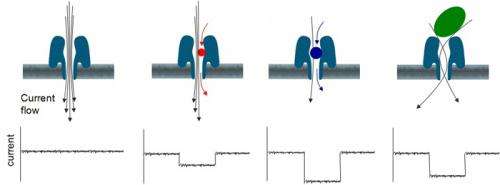February 17, 2014 report
Oxford Nanopore unveils portable genome sequencer – MinION

(Phys.org) —U.K. based Oxford Nanopore Technologies has made good on a promise made two years ago to produce an inexpensive genome sequencer that is based on nanopore technology. David Jaffe, with the Broad Institute reported to an audience at the Advances in Genome Biology and Technology meeting in Florida last week that he has been asked by Oxford Nanopore to try out the new the device, called the MinION, and has found it to be promising.
Oxford Nanopore Technologies created a stir in the biological sciences world in 2012 when representatives for the company announced that its research team had successfully created a sequencing device based on nanopore technology and that an inexpensive prototype would be delivered to researchers outside the company soon thereafter. The company apparently ran into difficulty ramping up its pore technology and had to find some alternative materials—thus the two year delay.
Nanopore sequencing is where single strands of DNA are pulled through a pore—as each base pair passes through the pore its conductivity is measured—information that can be used for identification by a computer. The advantage of this approach is that at least in principle, any strand length can be sequenced.
The MinION isn't for sale yet—at this time the company is making prototypes available to a select few notables in the genome sequencing field—each will have to pony up $1000 as a down-payment for the honor. The device plugs into a port on a computer, which does the processing. Along with the device, which has been compared to the size of a pack of gum, Oxford Nanopore Technologies will send along DNA samples that researchers can use to learn how to use the new device—after that, they can sequence anything they want. In testing strands of two types of bacterial DNA sent to him, Jaffe reports having mixed results —long stretches of data were obtained correctly in some cases, but in others there were some errors. In order to assemble the entire genome of a type of bacteria, for example, he had to also use a sequencing device made by another company. He noted that he is optimistic about the device, however, as reps from Oxford Nanopore have assured him that error rates can be reduced using certain techniques even as improvements to the device are being worked out back at the lab.
If the error rates using the MinION can be reduced to a practical level, the device could mark a turning point in gemone sequencing as it would be a device that could be carried and used for fieldwork. And though the cost of such a device has not been announced, Oxford Nanopore has repeatedly used terms such as inexpensive and affordable to describe it, indicating it will cost much less than other sequencing devices currently on the marker, once it's ready for sale.
More information: www.nanoporetech.com
© 2014 Phys.org
















